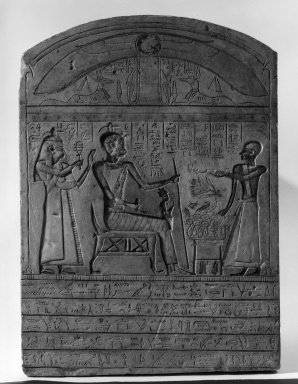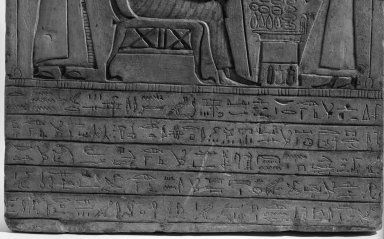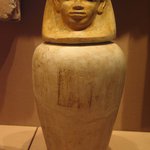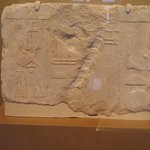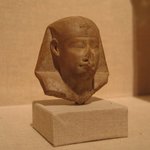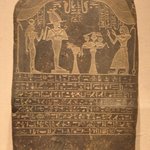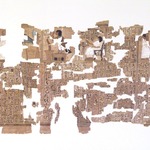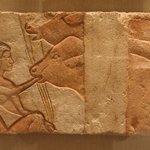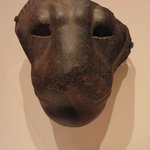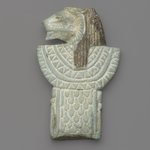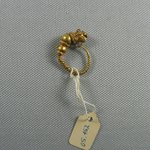Stela of Pakhaas
Egyptian, Classical, Ancient Near Eastern Art
On View: 19th Dynasty to Roman Period, Martha A. and Robert S. Rubin Gallery, 3rd Floor
The central vignette here features a unique combination of two types of stela illustration. Normally the deceased is shown offering to Osiris, lord of the underworld, or to another deity. Alternatively, the deceased and his or her spouse receive offerings from their family. At first glance, the stela seems to fit the second category. The dead person, Pakhaas, accompanied by his wife, Nesihor, who stands behind him holding a sistrum, or rattle, enjoys the oblations of his son, Pakhy (a nickname, in effect, Pakhaas, Jr.).
This scene, however, is hardly conventional. Pakhy’s censer and Nesihor’s sistrum rarely appear in scenes of offerings to humans, and Pakhaas is not depicted as a mortal. The small image of the god Osiris that sits on his knees suggests that Pakhaas has become that god. Pakhy thus becomes Horus, who offers to his dead father, Osiris, and Nesihor is Isis.
MEDIUM
Limestone, pigment
DATES
2nd–1st century B.C.E.
PERIOD
Ptolemaic Period
DIMENSIONS
14 3/4 x 10 5/8 x 1 5/8 in. (37.5 x 27 x 4.2 cm)
(show scale)
ACCESSION NUMBER
71.37.2
CREDIT LINE
Charles Edwin Wilbour Fund
CATALOGUE DESCRIPTION
Round-topped limestone stela. The top portion is decorated with a curved sign of heaven above a sun-disk with down-curved wings. Suspended from the disk are two cobras representing Wadjet and Nekhbet. Facing them are two jackals. Part of the original gilding is preserved on the sun disk; the sky was painted blue; traces of red are preserved on the disk's wings. The jackals are recumbent upon a base line below which is a horizontal sign of heaven. Traces of blue paint with red stars are preserved in this sign. Below, in a rectangular field flanked by was scepters are three figures. To the left, facing right, stands a woman holding a sistrum. She is the mother of the deceased who is shown in the center, facing right towards his son, separated from him by a table with offerings. The son offers incense and a liquid to his father. Figure of Osiris upon lap of deceased.
Condition: Chipped in upper left corner; small chips here and there. Diagonal gouge in lines three to five of main text. Much of the original paint and gilding preserved on the figures and their jewelry.
CAPTION
Stela of Pakhaas, 2nd–1st century B.C.E. Limestone, pigment, 14 3/4 x 10 5/8 x 1 5/8 in. (37.5 x 27 x 4.2 cm). Brooklyn Museum, Charles Edwin Wilbour Fund, 71.37.2. Creative Commons-BY (Photo: Brooklyn Museum, 71.37.2_SL1.jpg)
IMAGE
overall, 71.37.2_SL1.jpg. Brooklyn Museum photograph
"CUR" at the beginning of an image file name means that the image was created by a curatorial staff member. These study images may be digital point-and-shoot photographs, when we don\'t yet have high-quality studio photography, or they may be scans of older negatives, slides, or photographic prints, providing historical documentation of the object.
RIGHTS STATEMENT
Creative Commons-BY
You may download and use Brooklyn Museum images of this three-dimensional work in accordance with a
Creative Commons license. Fair use, as understood under the United States Copyright Act, may also apply.
Please include caption information from this page and credit the Brooklyn Museum. If you need a high resolution file, please fill out our online
application form (charges apply).
For further information about copyright, we recommend resources at the
United States Library of Congress,
Cornell University,
Copyright and Cultural Institutions: Guidelines for U.S. Libraries, Archives, and Museums, and
Copyright Watch.
For more information about the Museum's rights project, including how rights types are assigned, please see our
blog posts on copyright.
If you have any information regarding this work and rights to it, please contact
copyright@brooklynmuseum.org.
RECORD COMPLETENESS
Not every record you will find here is complete. More information is available for some works than for others, and some entries have been updated more recently. Records are frequently reviewed and revised, and
we welcome any additional information you might have.
Have the red and green colors been maintained? Or were they likely a completely different color when created?

Those pigments are original to the piece. Red and green mineral pigments are longer-lasting. Other colors, like blue, fade more rapidly and are no longer visible to our naked eye.




